AI SDR Integrations for Scalable Workflows

AI SDR Integrations for Scalable Workflows
AI-powered Sales Development Representatives (SDRs) are transforming enterprise sales by automating repetitive tasks like prospecting, outreach, follow-ups, and CRM updates. These tools allow sales teams to focus on closing deals and building stronger customer relationships. With seamless integration into CRMs, communication tools, and data platforms, AI SDRs enable real-time data syncing, automated workflows, and multichannel outreach.
Key takeaways:
AI SDRs boost productivity by handling thousands of prospects with personalized communication.
The AI Sales Assistant market is projected to reach $67.36 billion by 2030, growing at 20.2% annually.
Companies using AI SDR platforms report 25% more qualified leads and 30% shorter sales cycles.
Integration with CRMs like Salesforce and HubSpot eliminates manual data entry and ensures unified workflows.
Platforms like Persana AI, AiSDR Inc, and 11x.ai stand out for their automation capabilities, multichannel engagement, and real-time analytics. Choosing the right tool depends on your tech stack, workflow needs, and scalability goals.
I Automated an Entire SDR Team with AI (n8n & OpenAI)
::: @iframe https://www.youtube.com/embed/jzSEUwqmzDw :::
1. Persana AI
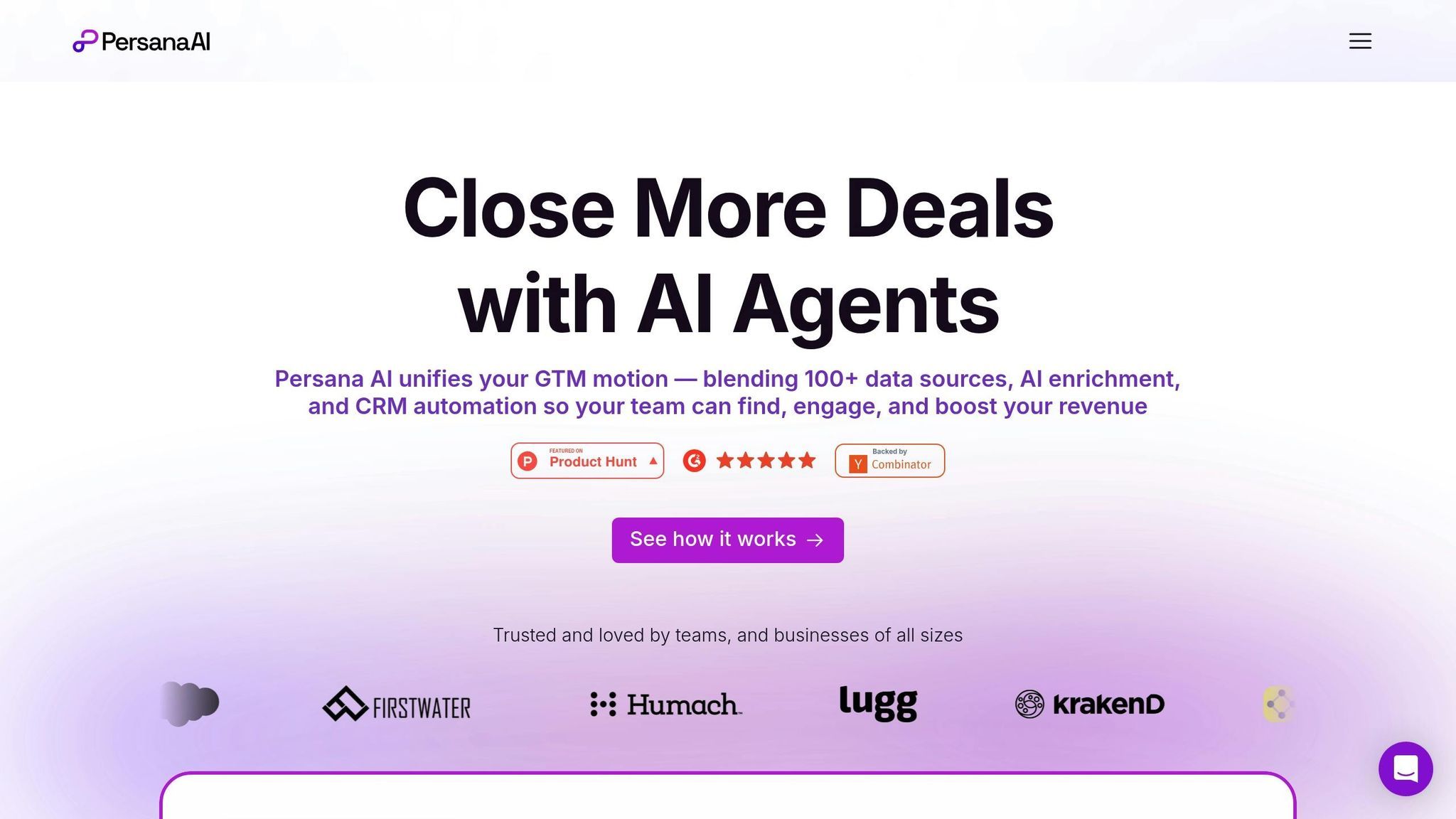
Persana AI's Alex AI SDR agent takes enterprise sales automation to a new level with a vast data network and seamless integration capabilities. With access to a database of over 1 billion contacts and data aggregated from more than 75 sources, the platform provides a strong foundation for scalable and efficient sales workflows[6].
Integration Breadth
Persana AI connects effortlessly with major CRMs and sales tools, pulling in data from over 75 sources to create enriched prospect profiles[6]. This means sales teams get access to detailed contact information, behavioral insights, and engagement signals - all without needing to jump between multiple platforms.
The platform also supports real-time data synchronization and automated workflow triggers. Sales teams can continue using their existing CRM setups while taking advantage of Persana AI's advanced prospecting features. By automating data entry and ensuring a steady flow of information across tools, the platform eliminates manual tasks and streamlines operations.
Workflow Automation Features
Alex AI simplifies outbound outreach by automating communication across email, LinkedIn, and other channels[6]. It uses real-time inputs to adjust its strategies, ensuring optimal engagement and meeting scheduling based on prospect behavior and market trends[6].
One of its standout features is its ability to handle repetitive tasks, like prospect research and follow-up sequences, freeing up SDRs to focus on higher-value activities. Despite being automated, Alex AI maintains a personalized touch in its communications.
Organizations adopting AI SDRs with similar automation tools have seen 25-40% growth in qualified leads and 15-30% faster conversion times when using a hybrid AI and human sales model[7]. Notably, AI SDRs like Alex AI can answer technical qualification questions 87% of the time, compared to just 15% for human SDRs, cutting qualification times from 8.3 days to an average of 2.1 days[7].
Data Enrichment and Analytics
Persana AI goes beyond automation by continuously enriching prospect data in real time. With information drawn from over 75 sources, sales teams always have up-to-date, actionable insights at their fingertips[6].
The platform's analytics focus on improving engagement by tracking metrics like response rates, meeting bookings, and pipeline progression. Alex AI uses these insights to fine-tune outreach strategies, ensuring better targeting and higher success rates. Its ability to process real-time signals allows for immediate campaign adjustments based on how prospects respond[6].
Scalability and Compliance
Persana AI is built to handle the demands of large-scale enterprise sales. Its automation tools can manage thousands of prospects simultaneously while still delivering personalized communication. This makes it a great fit for organizations with extensive databases and complex sales territories.
By combining automated workflows with robust data management, Persana AI provides the consistency and scale needed for enterprise sales. Teams can expand their outreach efforts without needing to grow their headcount at the same rate.
Companies using AI SDR platforms like Persana AI have reported 25-30% higher conversion rates and a 30% reduction in sales cycle time when the tools are fully integrated with their CRM and sales intelligence systems[4]. These gains come from the platform's ability to maintain consistent, data-driven engagement throughout the sales process.
2. AiSDR Inc
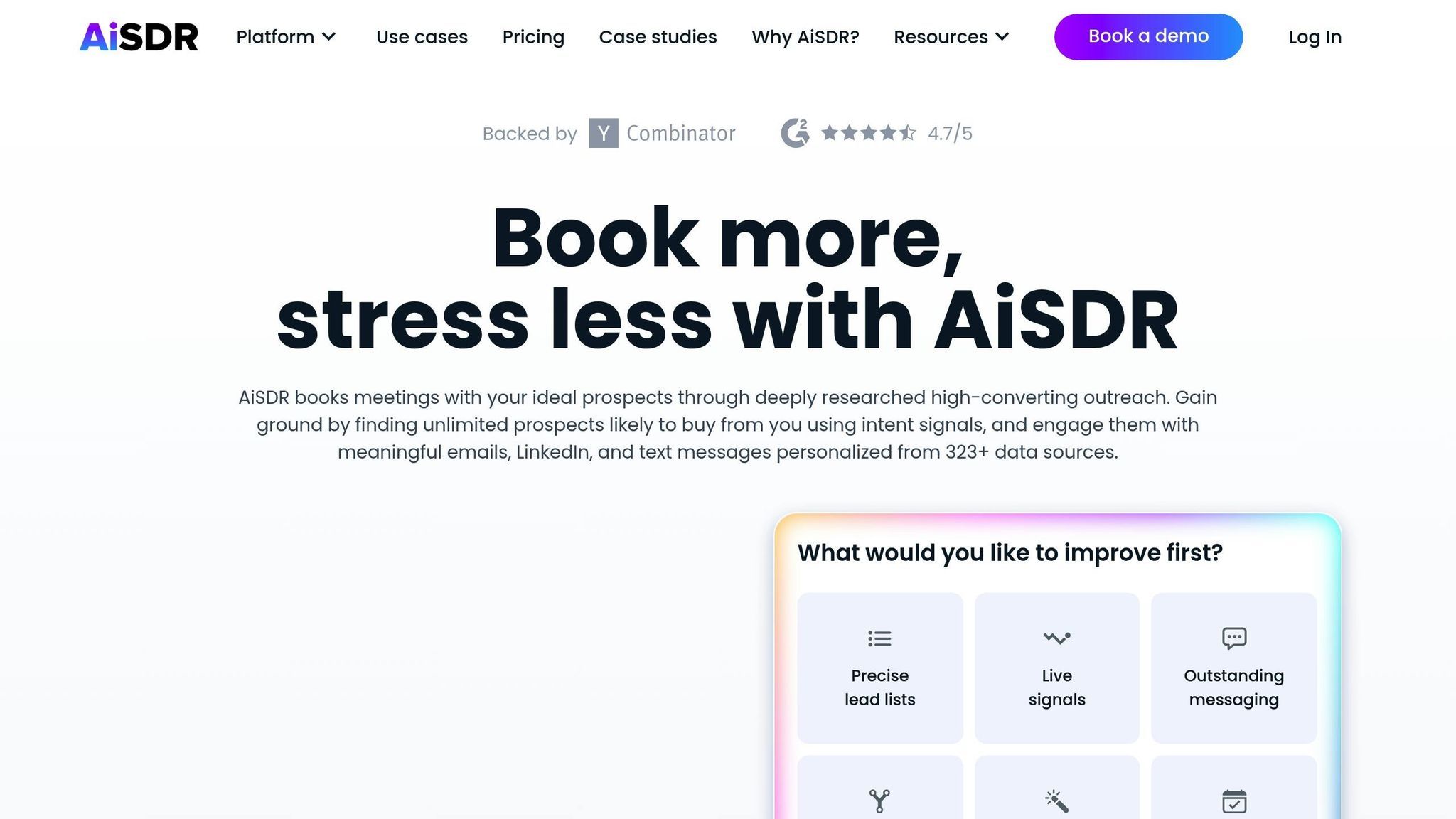
AiSDR Inc specializes in automating enterprise sales processes by combining multi-channel engagement with smart integrations. This approach helps manage high-volume prospecting while delivering tailored email and text outreach.
Integration Breadth
AiSDR Inc connects effortlessly with major CRM platforms like Salesforce, HubSpot, and Microsoft Dynamics. This allows enterprise sales teams to enhance their existing tools with AI-driven automation without disrupting their current workflows. The platform also integrates with tools like Slack, Gmail, and Outlook, creating a centralized hub for sales activities.
By linking with sales engagement tools such as Outreach and Salesloft, AiSDR Inc simplifies data management, bringing all prospect information into one place. This reduces the need for manual data entry and ensures accurate, up-to-date prospect records across the sales ecosystem.
Secure API connections and automated triggers keep CRM records current, schedule follow-ups, and monitor engagement in real time, providing a smoother workflow for sales teams.
Workflow Automation Features
AiSDR Inc takes automation to the next level by simplifying complex sales workflows. The platform handles tasks like lead qualification, personalized outreach, follow-up scheduling, and meeting bookings through flexible, multi-step workflows. Users can choose between full automation with "auto-pilot" or maintain some control with "co-pilot."
One standout feature is the 7-step Ideal Customer Profile (ICP) form, which uses intent data to refine lead research and targeting. Sales teams can also create custom triggers to align automation with their specific needs, such as scoring leads, timing outreach, or initiating follow-ups based on prospect behavior.
Data Enrichment and Analytics
The 7-step ICP form and intent data integration give AiSDR Inc an edge in prioritizing leads. By analyzing buying signals and engagement patterns, the platform highlights high-potential prospects, helping sales teams focus their efforts where it matters most.
Detailed analytics dashboards provide insights into key performance metrics like response rates, lead qualification rates, and engagement levels across channels. These tools enable teams to fine-tune their strategies and improve campaign outcomes based on actionable data.
Scalability and Compliance
Built for enterprise needs, AiSDR Inc handles large-scale operations with ease. Its automation capabilities and real-time analytics allow it to manage thousands of leads efficiently. The platform also ensures data security with encryption and compliance with regulations like GDPR and CCPA.
Features like audit trails and user access controls further strengthen data privacy and security as businesses scale their operations.
According to industry data, companies using AI SDR platforms with advanced integration capabilities, such as AiSDR Inc, see measurable improvements. Automation reduces manual tasks by up to 50%, while engagement rates increase by 20–30%, ultimately boosting lead conversion rates and productivity [2] [4].
3. 11x.ai
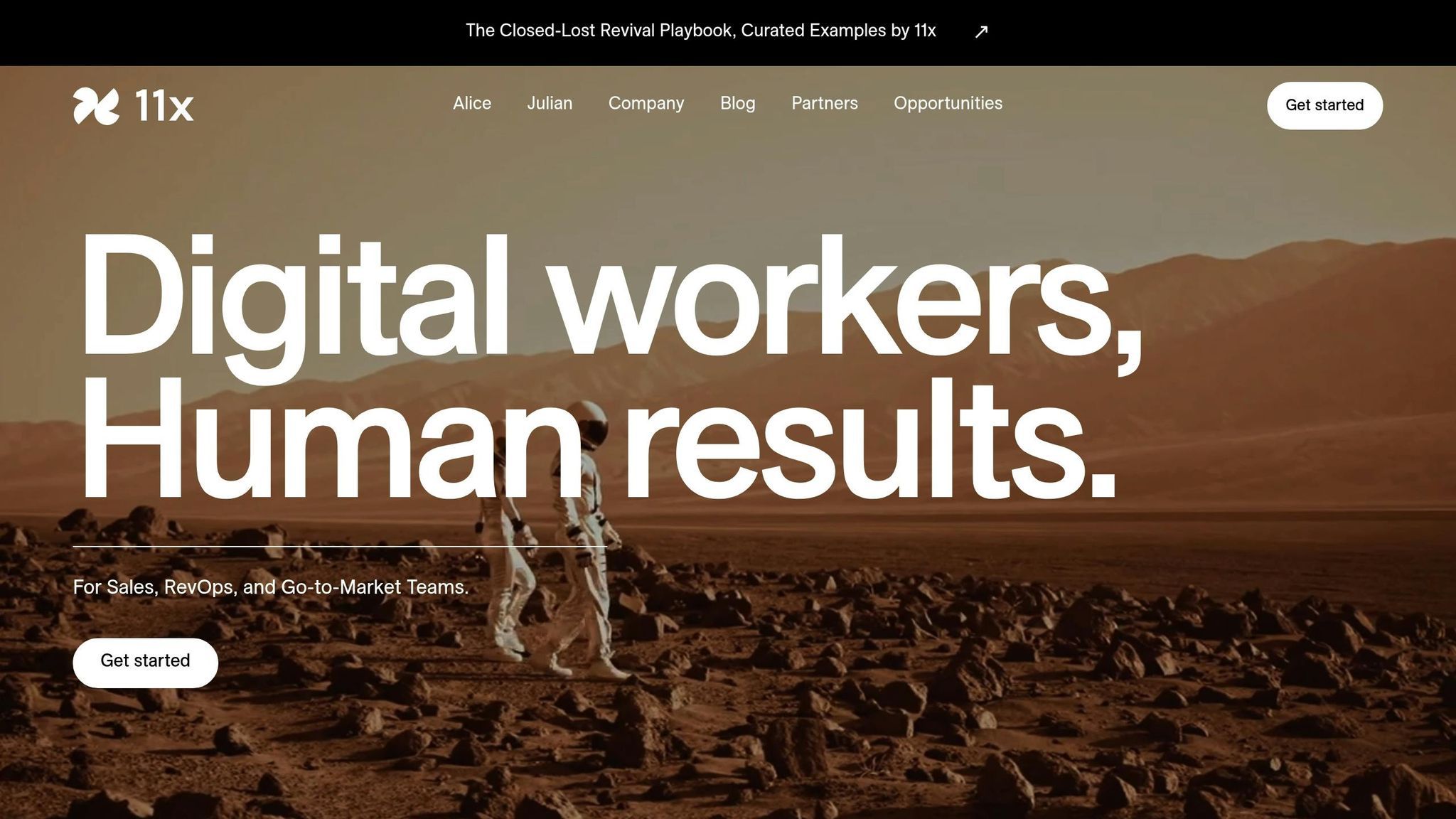
11x.ai approaches sales automation with a unique twist: it deploys digital workers that operate around the clock. Unlike conventional AI SDR tools that still rely heavily on human oversight, this platform features specialized AI agents designed to manage the entire sales process - from the first contact to closing deals.
Integration Breadth
The platform integrates seamlessly with existing tech ecosystems, connecting with major CRM systems, email providers, and communication tools. This allows the digital workers to access and update prospect data in real time, ensuring smooth operations across multiple sales channels.
What makes this integration so effective is its ability to coordinate actions across platforms. The digital workers pull data from various sources, analyze it intelligently, and execute tasks across different systems without requiring manual input. This interconnected approach lays the groundwork for the advanced automation features described below.
Workflow Automation Features
At the heart of 11x.ai are its digital workers: Alice, an AI SDR, and Julian, an AI phone agent. Alice handles multi-channel prospecting, autonomously driving qualified meetings and building a strong sales pipeline. She identifies potential leads, conducts research, personalizes outreach, and manages follow-ups - all without human intervention.
Julian, on the other hand, focuses on phone-based interactions, learning and adapting from every call to better align with business needs. Both digital workers operate independently, executing complex tasks with minimal input.
What sets these AI agents apart is their ability to continuously learn and improve. With each interaction, they expand their knowledge, refining their performance over time. Their contextual memory allows them to build detailed prospect profiles, enabling smarter and more personalized engagement. This eliminates the need for multiple specialized tools, streamlining the sales process into one cohesive system.
Data Enrichment and Analytics
The platform excels at gathering and analyzing prospect data. Its digital workers use a contextual memory system to store detailed information about every interaction, creating comprehensive profiles. These profiles help refine targeting and messaging, ensuring that future communications are more precise and effective.
By leveraging this data-driven approach, the digital workers can make informed decisions about the best timing, method, and content for engaging each prospect, leading to more meaningful and impactful interactions.
Scalability and Compliance
With its advanced automation and data capabilities, 11x.ai is built to scale. For instance, one company reported saving $500,000 in hiring costs by replacing traditional SDR roles with digital workers [8]. Another success story comes from Gupshup, a communications platform, which saw a 50% increase in SQLs per SDR after implementing this solution [8].
The platform also prioritizes security and compliance, meeting enterprise-grade standards such as SOC-2 certification. This ensures sensitive customer and prospect data remains protected as businesses expand their operations. Additionally, because the digital workers operate 24/7, sales activities can continue uninterrupted, even across time zones. This constant availability maximizes engagement opportunities while maintaining secure and reliable sales functions.
4. Lindy

Lindy stands out by focusing on customizable workflows rather than relying solely on standard automation. While many AI SDR platforms stick to predefined processes, Lindy gives sales teams the tools to create workflows tailored to their specific needs and brand identity.
Integration Breadth
Lindy takes a flexible approach to integrations, prioritizing adaptability over native connections. Using an open architecture, it connects to CRMs, email platforms, and other sales tools through APIs or custom connectors. This design allows businesses to seamlessly integrate Lindy into their existing tech stack.
Unlike platforms with pre-built integrations, Lindy requires a bit more setup but offers unmatched control over how tools interact. Sales teams can configure it to pull data from various sources and execute tasks across multiple systems, creating a unified workflow that fits their unique sales operations. This flexibility lays the groundwork for Lindy’s custom automation capabilities.
Workflow Automation Features
Lindy’s real strength lies in its customizable automation engine, which enables teams to design workflows for lead generation, outreach, follow-ups, and meeting scheduling. What makes Lindy different is the level of control it provides over communication style and brand alignment.
Sales teams can fine-tune the tone, messaging, and response logic, ensuring the AI agent feels like a natural extension of their brand. As a result, prospects interacting with Lindy-powered SDRs often can’t tell they’re engaging with an AI unless explicitly informed [5].
The platform automates a wide range of sales development tasks, from prospect research to multi-touch nurture sequences. This frees up sales reps to focus on more valuable activities, like building relationships and closing deals, while Lindy handles time-consuming, repetitive tasks. Additionally, Lindy’s analytics tools help teams refine and optimize these workflows.
Data Enrichment and Analytics
While Lindy’s core focus is automation, it also integrates enriched lead data from various sources. Its analytics offer insights into outreach performance, response rates, and conversion metrics, with the depth of analysis depending on the integrations configured.
These analytics allow sales teams to make smarter, data-driven decisions. By tracking which messaging strategies yield the best results, teams can continuously improve their workflows and fine-tune their automation for better outcomes.
Scalability and Compliance
Lindy’s architecture is designed to scale with enterprise needs. Workflows can expand or adapt without requiring a complete overhaul, making it suitable for growing teams or increasingly complex sales processes. It can handle higher lead volumes and more intricate operations as businesses evolve.
The platform also adheres to enterprise security and compliance standards. However, companies should ensure Lindy aligns with specific regulations like GDPR or CCPA during implementation to meet their unique compliance needs [5].
For a deeper dive into AI-powered SDR agents and scalable workflows, visit AI SDR Shop.
5. Cognism
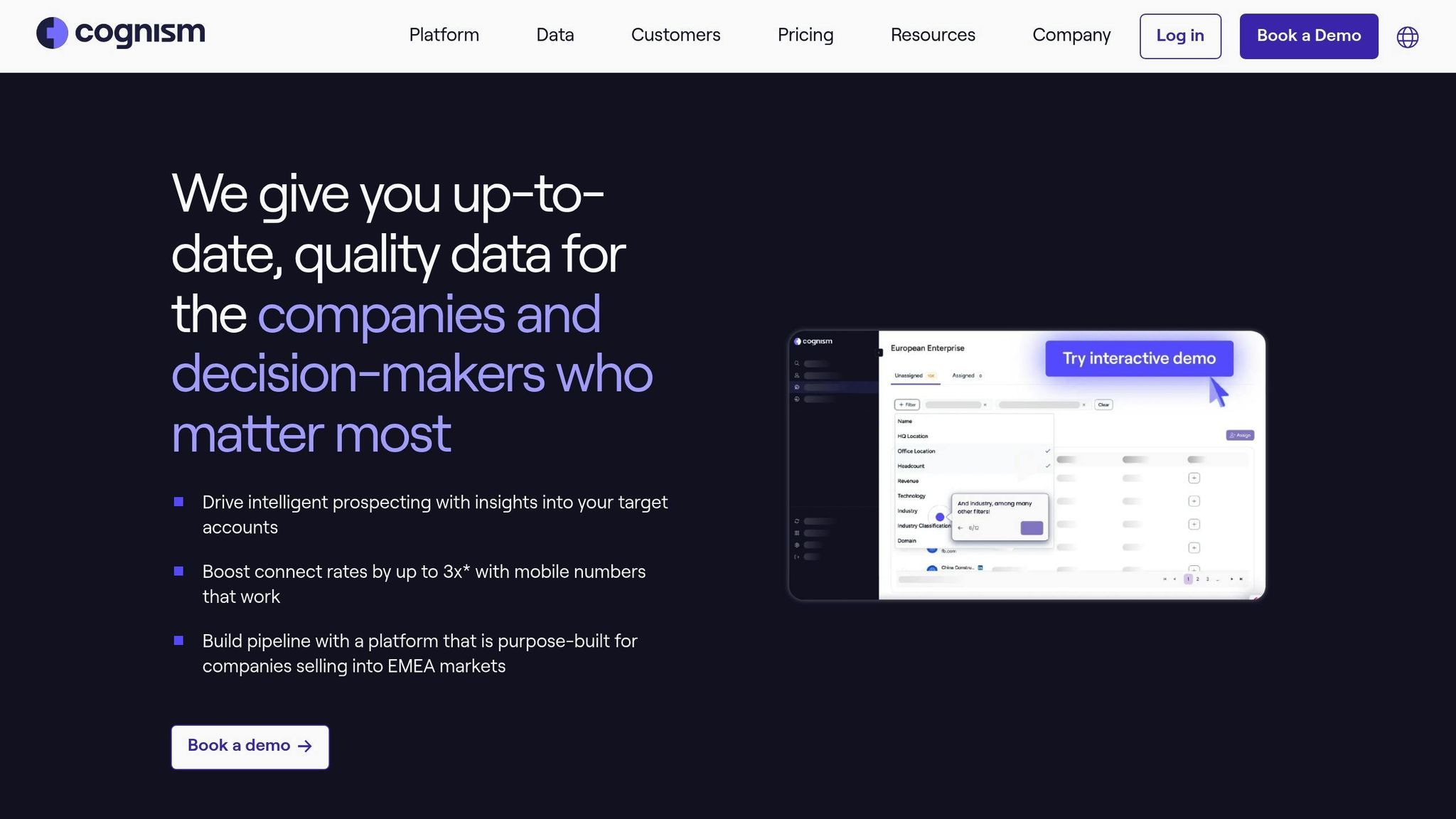
Cognism is a platform designed to prioritize high-quality, verified prospect data. It integrates seamlessly into enterprise workflows while adhering to strict compliance standards.
Integration Breadth
Cognism connects effortlessly with major CRM platforms like Salesforce and HubSpot, as well as marketing automation and sales engagement tools. These integrations eliminate the hassle of manual data transfers, creating a unified workflow. Thanks to pre-built connectors, sales teams can set up integrations with minimal technical effort, cutting down on IT overhead. This approach not only speeds up implementation but also reduces ongoing maintenance compared to systems requiring custom API development. With Cognism, enriched prospect data syncs directly into existing tools, ensuring verified contact details and firmographic information are readily available. This seamless integration supports the automation of essential prospecting tasks [4][9].
Workflow Automation Features
Cognism streamlines prospecting by automating key workflows, such as trigger-based data enrichment and targeted outreach. For example, when a new lead enters Salesforce, Cognism enriches the record automatically and integrates it into sales cadences, reducing manual data entry and accelerating outreach. In Q2 2023, a global tech company using Cognism alongside Salesforce saw a 35% increase in qualified leads and a 20% reduction in sales cycle time. This highlights how automation powered by verified data can significantly boost pipeline generation [4].
Data Enrichment and Analytics
Cognism’s database includes over 100 million B2B contacts and 20 million companies, boasting a 95% accuracy rate for contact data. While many platforms offer data enrichment, Cognism stands out for its commitment to compliance. By appending verified emails, direct dials, and firmographic details to prospect records, it enhances targeting accuracy. A financial services firm in the U.S. leveraged these features to achieve a 28% increase in conversion rates over six months. Additionally, Cognism’s analytics tools provide customizable dashboards to track integration health, data synchronization, and key metrics like lead conversion and engagement rates, enabling sales leaders to refine their strategies and demonstrate ROI [4][9].
Scalability and Compliance
Built on a cloud-based infrastructure, Cognism is designed to handle the demands of large enterprises, efficiently processing millions of records for multiple users. Its compliance features are particularly robust, incorporating GDPR and CCPA mechanisms such as real-time data validation, consent management, and audit trails. By automatically suppressing opted-out contacts and maintaining clear data provenance, Cognism ensures adherence to strict regulatory standards. Companies using the platform often report a 30% boost in sales productivity and a 25% improvement in conversion rates. These features allow sales teams to expand their efforts without compromising data quality or compliance [4][9].
For a detailed comparison of AI-powered SDR platforms and their integration capabilities, check out the comprehensive analysis available at AI SDR Shop, which covers over 80 solutions.
sbb-itb-4c49dbd
6. MeetChase AI
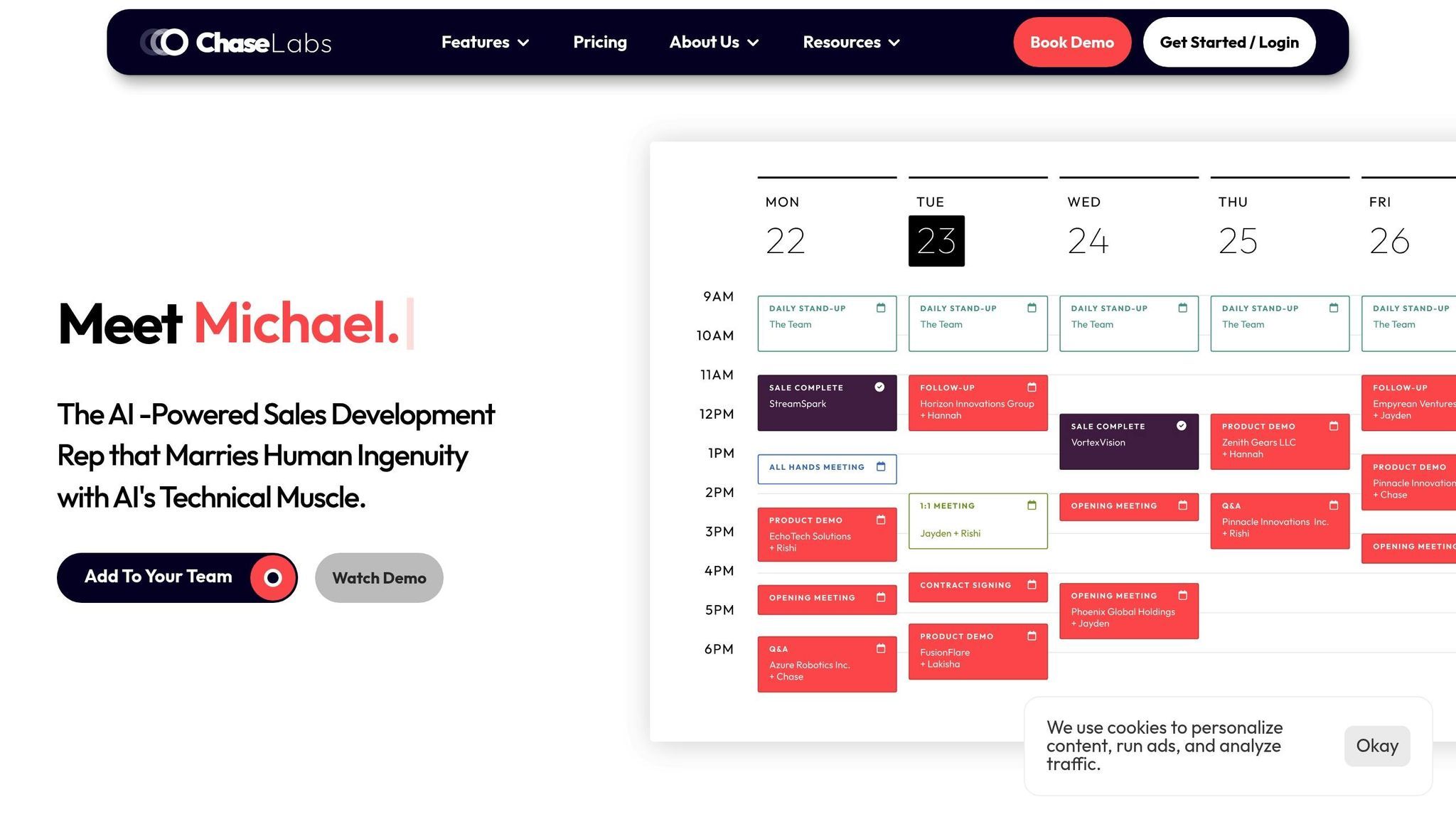
MeetChase AI is a smart SDR platform designed to keep prospect engagement running smoothly. It focuses on autonomously identifying buyer intent and managing multi-channel outreach through email, LinkedIn, and SMS.
Integration Breadth
MeetChase AI works seamlessly with top CRM systems like Salesforce and HubSpot, as well as essential email and calendar tools commonly used by enterprise sales teams. This setup ensures automatic syncing of data and smooth lead management, fitting right into existing workflows. What sets it apart is its easy-to-use interface, which requires minimal IT involvement. Whether you're tech-savvy or not, its workflow builder makes integration with tools like Salesforce, HubSpot, email, and calendars straightforward [1][4]. This hassle-free integration lays the groundwork for its automated workflow capabilities.
Workflow Automation Features
The platform takes care of the entire SDR process - from finding prospects to sending personalized messages, scheduling follow-ups, and even booking meetings. It uses smart triggers that adapt based on how prospects engage. For instance, a U.S.-based SaaS company saw impressive results after adopting MeetChase AI: a 30% boost in qualified meetings booked and a 25% drop in manual data entry within just three months. These gains were tied to its smooth CRM integration and automated workflows [4]. By automating these tasks, sales teams not only save time but also improve the accuracy of their data and gain actionable insights.
Data Enrichment and Analytics
MeetChase AI takes lead data to the next level by automatically validating and enriching it with firmographic and behavioral insights. This ongoing process helps improve lead quality and supports more tailored outreach strategies. Its analytics dashboard offers a clear view of outreach performance, interaction rates, and pipeline health, giving sales leaders the tools they need to make informed decisions. The centralized dashboard is designed to simplify campaign management while offering a detailed look at how well campaigns are performing [4].
Scalability and Compliance
Built on the cloud, MeetChase AI can handle thousands of prospects at once without breaking a sweat. It also comes with strong compliance features, including data encryption, audit trails, and customizable permission settings, ensuring it aligns with U.S. data privacy laws like CCPA. The platform also supports opt-out management and consent tracking, helping businesses stay on the right side of privacy regulations. This scalability allows sales teams to expand their outreach efforts without needing to hire more staff. Analysts highlight its ability to unify data across platforms and automate complex workflows as a major advantage for enterprises looking to scale outbound sales efficiently [4].
That said, users should be aware that advanced customization might require extra configuration or support. Additionally, integration with less common or outdated systems may be more limited compared to mainstream platforms.
7. Apollo.io
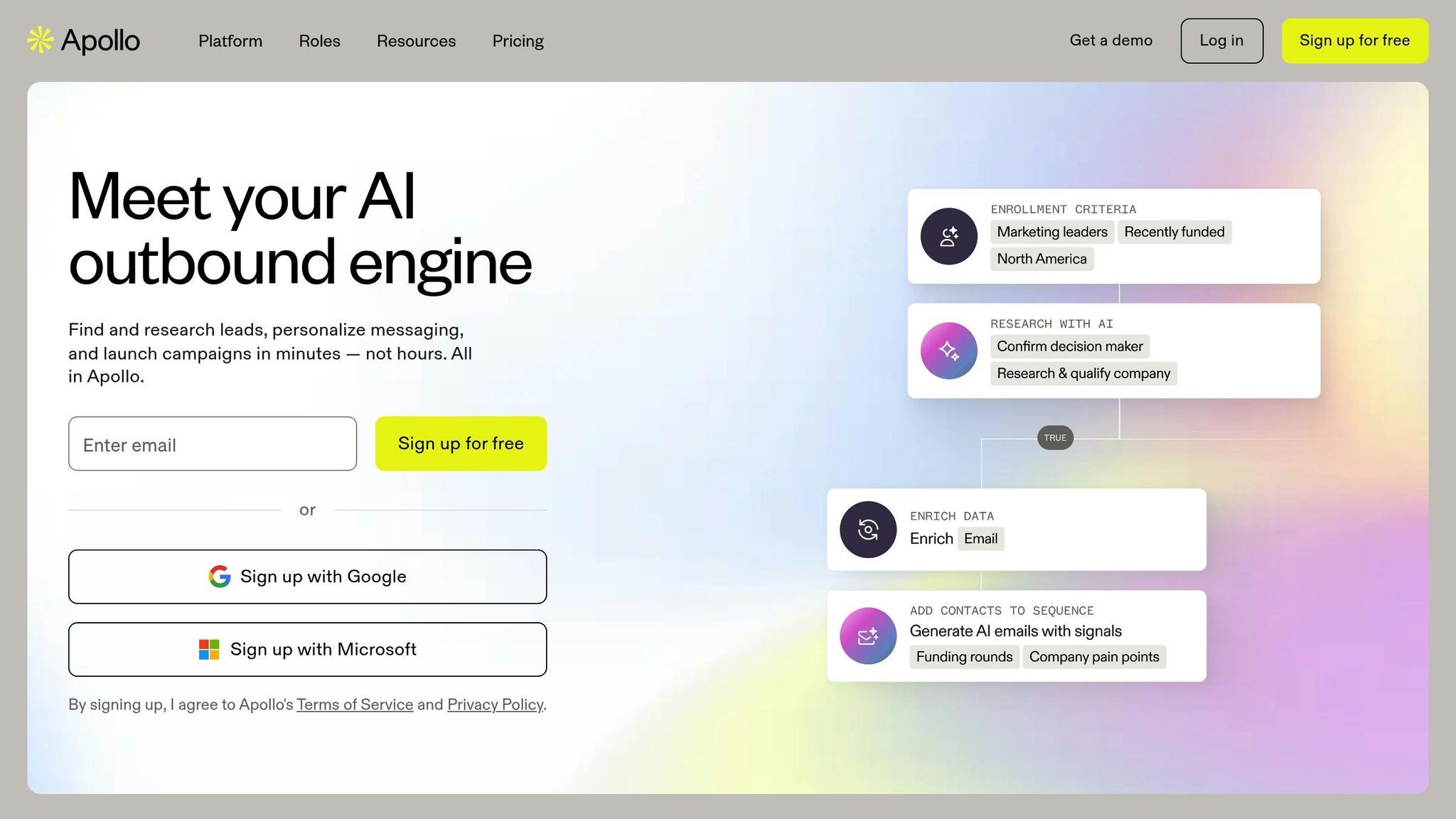
Apollo.io is a powerful AI-driven sales platform that combines prospecting, engagement, and analytics into one streamlined solution. Built on a vast and highly accurate business data network, it helps enterprise sales teams manage everything from lead generation to deal closure. Let’s dive into how Apollo.io’s integration capabilities and workflow automation make it a standout choice.
Integration Breadth
Apollo.io seamlessly integrates with major CRMs and sales tools, ensuring smooth data flow across your entire sales tech stack. Beyond simple data syncing, it actively cleans and updates records, keeping CRM systems accurate and up to date. This is especially valuable for companies juggling large volumes of prospect data, as it eliminates the manual work of maintaining clean records.
Workflow Automation Features
The platform’s AI-powered engine simplifies complex prospecting workflows. It handles tasks like lead identification, automated outreach, meeting preparation (with insightful pre-meeting data), and follow-ups, all supported by real-time alerts. Features like real-time form enrichment and visitor identification ensure inbound leads are instantly qualified. Additionally, pipeline boards and deal alerts keep teams informed about opportunities without the need for constant manual tracking.
Data Enrichment and Analytics
Apollo.io’s automated workflows are backed by a robust data enrichment engine that delivers tangible results. With a database of over 210 million contacts and 30 million companies[10], it’s one of the most extensive business data resources available. Advanced filtering options allow users to target prospects based on job title, seniority, company size, location, industry, and even buyer intent signals. Continuous data enrichment ensures information remains current and actionable.
For example, Census, a data operations company, reported a 4x increase in contact data and a 50% improvement in data quality - all while reducing platform costs by 64% after switching to Apollo[10].
Mark Turner, VP of Revenue Operations at Built In, shared, "Apollo enriches everything we have: contacts, leads, accounts. We don't really have to touch it, it just works"[10].
Apollo.io also provides an analytics dashboard that tracks metrics like open rates, response rates, and pipeline growth. These insights allow sales leaders to refine strategies and coach their teams more effectively. Conversation insights further help identify patterns in successful interactions, enabling teams to replicate winning tactics throughout their sales process.
Scalability
Designed with enterprise-scale operations in mind, Apollo.io’s cloud-based infrastructure ensures top-notch performance, even under heavy workloads. The platform supports high-volume prospecting by continuously updating and enriching data, making it ideal for businesses aiming to expand their outbound sales efforts. For instance, Kinsta achieved a 36% connection rate, while Cyera saw a 75% increase in booked meetings after adopting Apollo.io[10].
Apollo.io’s ability to scale without compromising performance makes it a go-to solution for enterprise teams seeking to automate and grow their sales processes efficiently.
8. Salesloft
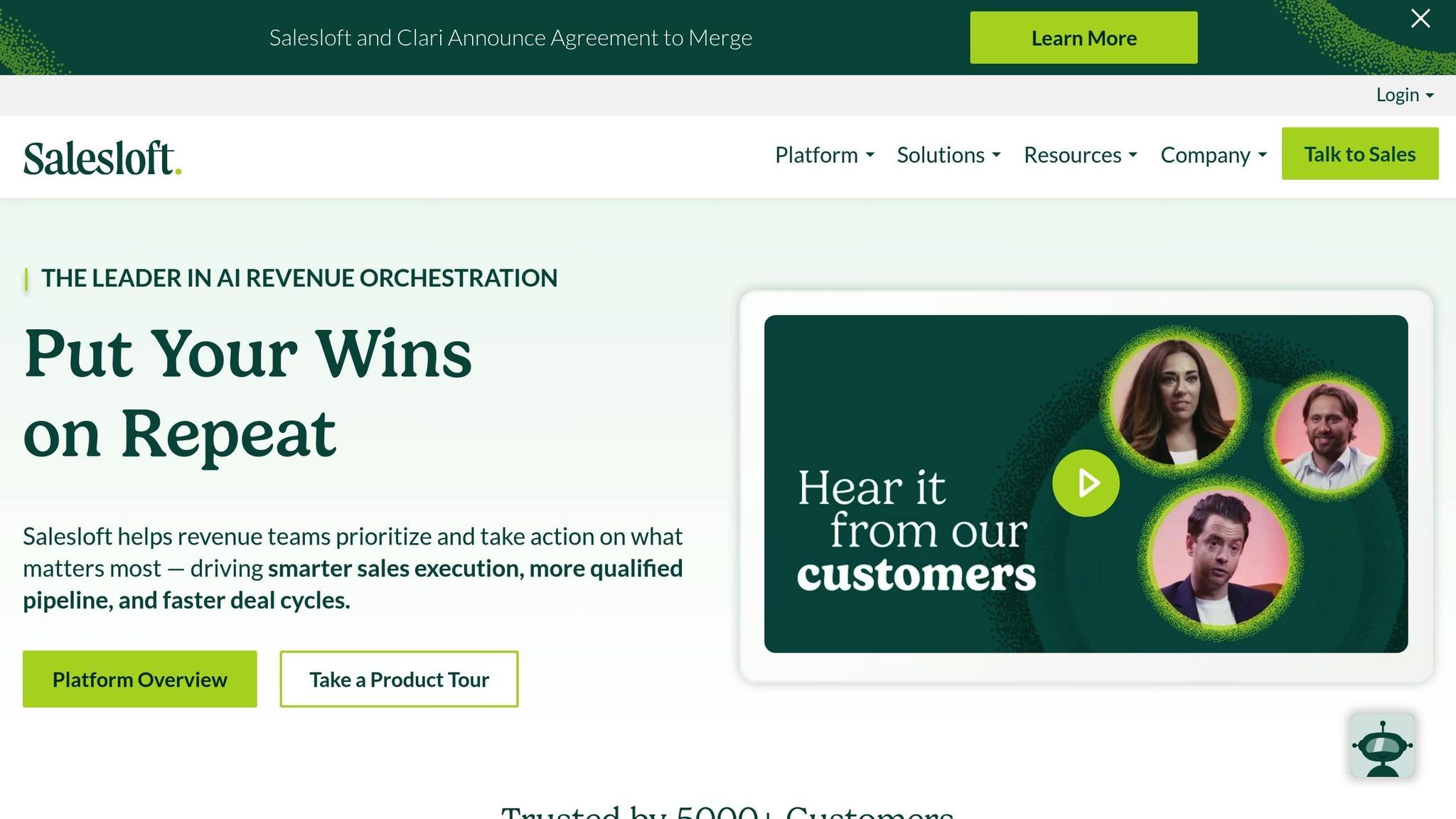
Salesloft brings together enterprise sales workflows with a platform designed to integrate and automate processes seamlessly. Its standout feature is its ability to connect various sales tools while ensuring data accuracy and consistent workflows.
Integration Breadth
Salesloft connects with over 100 platforms, creating smooth transitions between sales, marketing, and customer service teams. Its integrations with major CRM systems like Salesforce, HubSpot, and Microsoft Dynamics ensure customer data flows effortlessly across all touchpoints.
The platform also works well with marketing automation tools such as Marketo, Pardot, and Eloqua, enabling teams to run coordinated campaigns and nurture leads effectively. Communication tools like Slack, Microsoft Teams, and Google Workspace are supported too, helping teams stay aligned and informed about prospect activities.
One example of its impact comes from its deep integration with Salesforce. A financial services firm saw a 20% boost in lead conversion rates after leveraging Salesloft's automation and data enrichment features through this integration[3].
Workflow Automation Features
Salesloft simplifies repetitive tasks through automation while maintaining a personal touch. Its automated email sequencing adjusts follow-up times based on how prospects engage. Additionally, it handles tasks like call scheduling, meeting coordination, and task assignments, freeing up time for sales teams to focus on closing deals.
Custom automation rules can trigger specific actions based on factors like prospect behaviors, CRM updates, or time-based conditions, ensuring no lead is overlooked.
In Q2 2023, a global tech company adopted Salesloft's workflow automation and saw impressive results: a 25% boost in sales productivity and a 15% reduction in sales cycle time. These gains were credited to the platform's ability to automate repetitive tasks and provide real-time analytics for better decision-making.
Data Enrichment and Analytics
Salesloft's analytics dashboard provides real-time insights into team activities, engagement metrics, and pipeline health. Its conversation intelligence feature analyzes sales calls and interactions, offering actionable insights for coaching and refining strategies.
The platform tracks key metrics like email open rates, response rates, and meeting conversions, helping teams identify the most effective messaging and timing for different prospects. The deal intelligence feature keeps tabs on pipeline health, alerting teams to at-risk opportunities before they slip away.
Customizable dashboards allow sales managers to monitor everything from individual rep performance to team-wide conversion rates. This detailed visibility helps pinpoint bottlenecks and allocate resources efficiently as teams grow.
Scalability and Compliance
Salesloft is built to grow with enterprise needs. It supports role-based access, audit logs, and strong security measures to ensure smooth scaling. Its cloud-based architecture enables organizations to add users and expand workflows without sacrificing performance or compliance.
The platform adheres to key data protection regulations, including GDPR and CCPA, ensuring customer data is managed securely. For U.S. businesses, Salesloft offers options like data residency, audit trails, and encryption for both data at rest and in transit, meeting stringent privacy and security standards[3].
Salesloft's scalability also extends to handling complex workflows. As sales processes evolve and teams expand, its automation and integration features adapt without requiring extensive reconfiguration. This makes it a powerful tool for enterprise teams aiming to streamline operations and drive efficiency.
9. Outreach
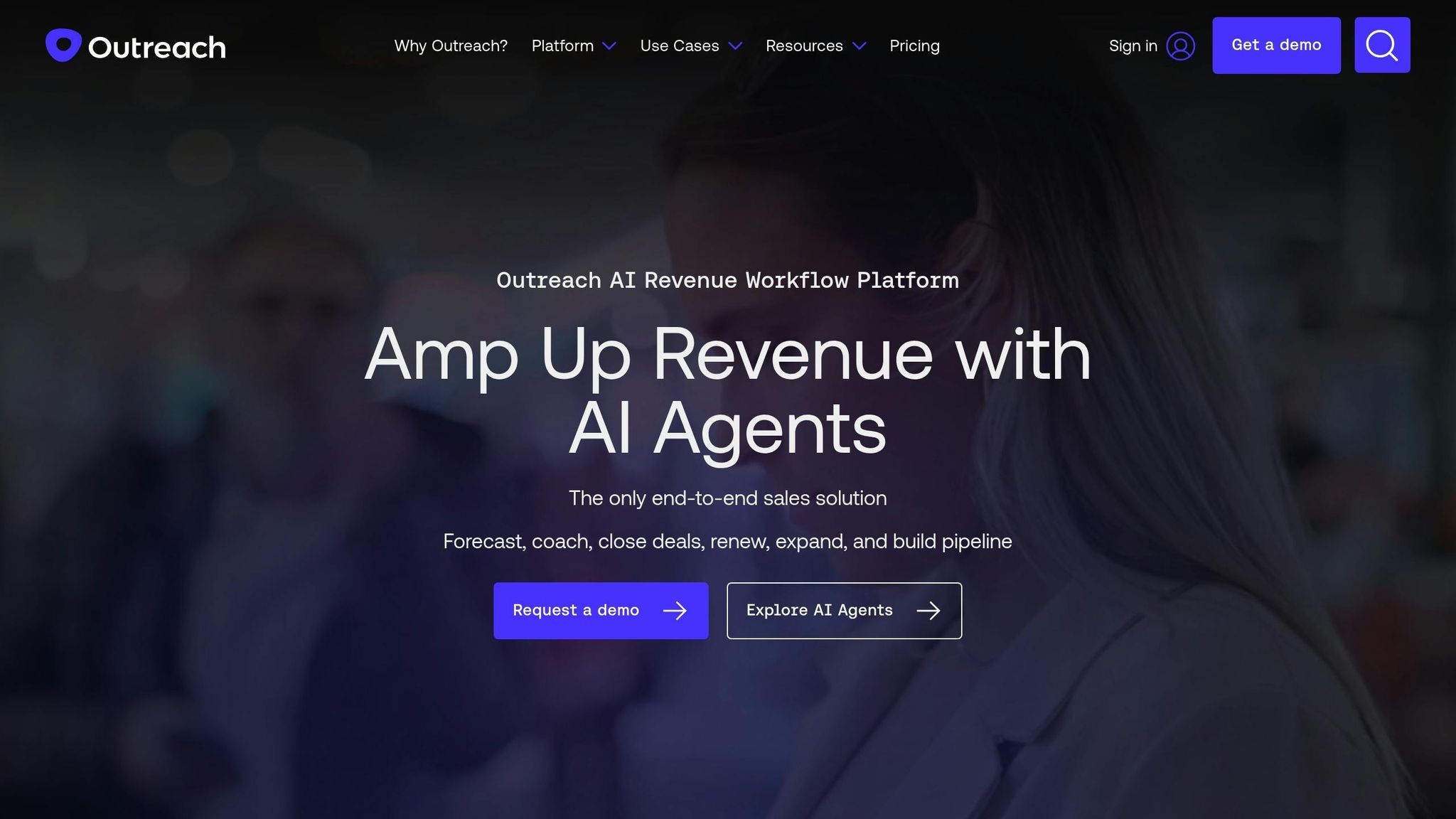
Outreach is a sales execution platform that brings together prospecting, engagement, and deal closure into one streamlined system. It offers enterprise teams tools for automation, insights, and workflow management to handle every aspect of the sales process.
Integration Breadth
Outreach integrates seamlessly with a wide range of enterprise tools, making it a valuable addition to any sales tech stack. It connects with leading CRM systems, ensuring that data on prospects and deals syncs automatically, eliminating the need for manual updates. Beyond CRMs, Outreach works with communication tools like Slack and Zoom, allowing teams to schedule meetings, receive notifications, and collaborate without leaving their usual workflows. It also supports marketing automation platforms and data enrichment tools, providing a complete picture of a prospect's journey from first contact to deal closure. These integrations lay the foundation for the platform's powerful automation capabilities.
Workflow Automation Features
Outreach simplifies complex sales processes with its automation features. For instance, its conversation intelligence analyzes sales calls, offering actionable feedback to improve coaching. The deal intelligence function tracks deal progress, identifies risks, and suggests next steps to keep deals moving forward. Routine tasks, like scheduling follow-ups based on call outcomes, syncing CRM data, and generating performance reports, are automated, cutting down administrative work by 20–30%[3]. This allows sales teams to focus more on engaging prospects and closing deals.
Data Enrichment and Analytics
The platform's revenue intelligence tools provide a clear view of the sales pipeline, forecasting insights, and team performance metrics - all accessible from a single dashboard. Conversation intelligence identifies successful patterns in sales interactions, helping teams adopt proven strategies. Companies using AI-driven sales tools integrated with CRMs have reported a 25% boost in qualified leads and a 30% reduction in sales cycle time[4]. These analytics not only enhance sales strategies but also support the platform's ability to scale with the needs of large organizations.
Scalability and Compliance
Outreach is built to handle the demands of enterprise-scale operations, accommodating thousands of users and large data volumes through its CRM integrations. Its features are designed to scale effortlessly, enabling teams to grow without being bogged down by additional administrative work. The platform ensures consistency across organizations by standardizing coaching practices and sales methodologies, regardless of team size. Distributed teams can collaborate effectively, thanks to its seamless integrations. For businesses expanding globally, Outreach's compliance with certifications like SOC 2 Type II, HIPAA, and GDPR ensures data security and regulatory adherence. With unified visibility into customer interactions, Outreach keeps sales processes efficient, even as teams grow rapidly.
Platform Advantages and Drawbacks
Every platform brings its own set of strengths and challenges, particularly when it comes to integration, automation, and scalability. Understanding these differences allows organizations to make well-informed decisions that align with their specific needs and existing tech infrastructure.
One key distinction lies in native integration versus third-party flexibility. For example, Salesforce's Agentforce SDR showcases the benefits of native integration by offering seamless access to reliable data within the Salesforce ecosystem. It also provides a familiar interface for current users, reducing implementation time and avoiding data synchronization issues[2]. However, this convenience comes at the cost of vendor lock-in, which can be restrictive for organizations relying on multiple CRM systems.
On the other hand, platforms like Persana AI, AiSDR Inc, and Lindy are designed to support a variety of integrations. These platforms allow businesses to retain their existing tech stack while adding AI-driven capabilities. They can connect with tools like Salesforce, HubSpot, Slack, and Zoom to enable comprehensive workflow automation[3]. That said, this flexibility often involves more complex setup processes and the risk of inconsistent data across systems.
Multichannel Outreach Capabilities also vary widely among platforms. AiSDR Inc supports real-time engagement through email and text messaging across multiple channels simultaneously[1]. Alice by 11x.ai focuses on integrating email and LinkedIn while analyzing behavioral data for deeper insights[1]. SuperAGI takes things further by offering outreach capabilities across email, LinkedIn, SMS, and WhatsApp, ensuring SDRs can reach leads on their most active platforms[4]. These multichannel features are proven to boost engagement, as demonstrated in earlier examples.
When it comes to automation depth and control, platforms differ in how much autonomy they provide. Regie.ai, for instance, offers two modes: Auto-pilot Mode for full automation and Co-pilot Mode for real-time assistance while SDRs remain in control[2]. Agentforce SDR provides 24/7 prospect engagement with autonomous, human-like decision-making[2]. Meanwhile, Lindy emphasizes customizable workflows, enabling businesses to adapt automation to their unique requirements[5].
Below is a summary of the main strengths, challenges, and ideal use cases for several platforms:
| Platform | Advantages | Drawbacks | Best Fit |
|---|---|---|---|
| Persana AI | Broad integration options, CRM compatibility | May require significant CRM investment | Enterprises with diverse tech stacks |
| AiSDR Inc | Precise targeting, email + SMS automation | Limited functionality outside supported CRMs | Teams focused on targeted outreach |
| 11x.ai (Alice) | Behavioral insights, Email + LinkedIn focus | Limited deep CRM integration | Businesses prioritizing prospect intelligence |
| Lindy | Flexible workflows, broad integrations | Requires setup time and learning curve | Companies needing tailored solutions |
| Cognism | Large data access, compliance features | Complex regulatory compliance requirements | Global enterprises with strict regulations |
| Apollo.io | All-in-one database and analytics | Can overwhelm smaller teams | Mid to large enterprises seeking robust tools |
| Salesloft | Advanced analytics, Salesforce integration | Higher cost, steep learning curve | Salesforce-centric organizations |
| Outreach | Conversation intelligence, deal tracking | Extensive integration setup required | Teams focused on coaching and analytics |
Lead Research and Qualification methods also play a critical role in workflow efficiency. AiSDR uses a combination of intent data and a 7-step ICP form for highly accurate targeting[1]. Alice by 11x.ai takes a different approach, leveraging behavioral data to gain deeper insights into prospects[1]. Additionally, businesses using conversational intelligence tools - such as those offered by Gong.io - report a 25% increase in qualified leads and a 30% reduction in sales cycle times[4].
Lastly, scalability considerations highlight key trade-offs. Native integration simplifies setup and ensures consistent data but risks vendor lock-in. Platforms supporting multiple integrations offer greater flexibility but can introduce setup challenges and data consistency issues. All-in-one solutions minimize tool sprawl but may lack the specialized capabilities some enterprises need for complex sales processes. For companies standardized on Salesforce, native integration offers a streamlined approach. Meanwhile, businesses with diverse, multi-tool environments may benefit more from platforms that support a wider range of integrations.
To help organizations navigate these options, AI SDR Shop offers a directory of over 80 AI SDR platforms, complete with detailed information on features, integrations, and use cases. This resource can guide businesses in selecting the right platform to meet their workflow and scalability needs.
Conclusion
Choosing the right AI SDR integration means finding a platform that fits seamlessly into your workflow and tech setup. A well-matched integration can boost efficiency and deliver tangible results[1][2][11].
For organizations heavily reliant on Salesforce, native CRM integration is often the smoothest option. Tools like Agentforce SDR simplify data management and offer familiar interfaces that speed up implementation. However, this convenience comes with a trade-off: higher CRM costs and limited flexibility for future adjustments[11].
If flexibility is your priority, platforms such as Persana AI, AiSDR Inc, and Lindy allow you to enhance your existing tech stack with AI capabilities. While these options provide more freedom, they typically involve more intricate setups.
Multi-channel communication is now a must-have for scalable workflows. Companies that adopt integrated AI solutions often see a 25% rise in qualified leads and a 30% reduction in sales cycle time[4]. Platforms like SuperAGI enable SDRs to engage with leads across email, LinkedIn, SMS, and WhatsApp, ensuring outreach happens where prospects are most active[4]. This level of connectivity plays a critical role in determining the right balance of automation for your strategy.
Ultimately, the decision comes down to finding the right mix of automation and human input to meet your scalability and personalization goals.
For an in-depth comparison of over 80 AI SDR platforms, check out AI SDR Shop.
Whether you opt for a streamlined native solution or a more flexible multi-platform approach, automating repetitive tasks so your team can focus on closing high-value deals is the real game-changer.
FAQs
How do AI SDR tools integrate with CRM systems, and how can this benefit sales teams?
AI SDR platforms work hand-in-hand with CRM systems, often connecting through APIs or built-in connectors. This setup allows data to flow effortlessly between the two, ensuring customer details, lead activities, and sales updates are refreshed in real-time. The result? Less manual data entry and fewer mistakes. For sales teams, this integration simplifies daily processes. It enhances lead management, makes outreach more tailored, and speeds up follow-ups. By taking over repetitive tasks, these platforms free up time for teams to concentrate on what really matters - building relationships and closing deals. The payoff? Greater efficiency and, ultimately, more revenue.
What should I look for in an AI SDR platform to build scalable sales workflows?
When choosing an AI SDR platform to build scalable sales workflows, there are a few essential aspects to keep in mind. First, check if the platform integrates smoothly with your existing tools, such as your CRM, communication apps, and sales software. This ensures data flows effortlessly between systems, reducing the need for tedious manual input. Next, look into the customization features. The platform should align with your sales processes, giving you the flexibility to adjust workflows, tailor messaging, and prioritize leads in a way that suits your team’s specific requirements. Lastly, think about the platform's ability to grow with your business and the quality of its support. It should be capable of managing larger data sets and accommodating a growing team. Reliable customer support is also crucial to quickly resolve any challenges that arise. For a detailed comparison of AI SDR platforms and their capabilities, resources like AI SDR Shop can help you identify the best match for your business.
How do AI SDR tools shorten the sales cycle and boost lead conversion rates?
AI SDR tools take the hassle out of repetitive sales tasks like lead qualification, follow-ups, and personalized outreach. By processing massive amounts of data in no time, they pinpoint promising leads and engage them with customized messages, speeding up the journey through the sales funnel. What’s more, these tools work around the clock, ensuring every lead gets attention and inquiries are addressed promptly. Their consistent, data-backed communication not only keeps prospects engaged but also strengthens trust, boosting conversion rates and making the sales process more efficient.